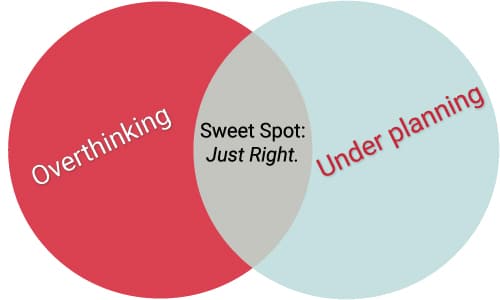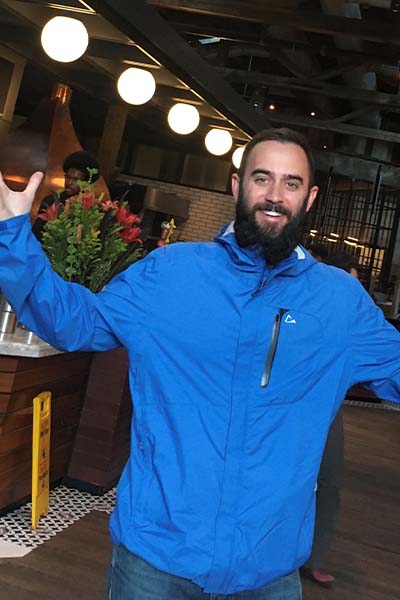How do you find that magical sweet spot between overthinking and under planning in your marketing efforts? It can be elusive, for sure. I know this because we’ve worked with thousands of marketers in our agency’s history. So we’ve noticed that there’s an “approach to planning spectrum” that looks like this:
On one end, there are the people who say stuff like, “can’t we just launch the website now and worry about the booking engine later?” and “we’ll loop operations and guest services in later, for now let’s just push it out.”
And on the other end, there are the folks who say stuff like, “we don’t have a decision on that (thing that was due last month) because we’re still waiting for (insert random department here) to get us their feedback.” and “I know we approved that logo three times already but can we just see it again with this change?”
Those are the two extremes on the spectrum. And the sweet spot is in the dead center of those polar opposites. Dropped into a handy Venn Diagram, it looks like this:

It might seem obvious, but here’s why you want to operate within the sweet spot between overthinking and under planning.
Because with overthinking, you miss opportunities.
Because with under planning, you miss opportunities.
Either way, you’re fumbling at the goal line. But it’s so interesting that such extreme opposing behaviors could have the same result: missed opportunities. What kind? ALL KINDS. Lost sales, being left out of editorial coverage, loss of competitive advantage, and much more. And tourism is such a seasonal business, so missing a marketing window here often means waiting an entire year to get that opportunity again.
If you or your organization tend to operate within one of those extreme end zones, fear not. You’re not alone. Both extremes are incredibly common. But since they cause your marketing efforts to miss opportunities, you might consider how to nudge habits toward the sweet spot.
Here’s some advice.
STEP ONE: AWARENESS…DO YOU RECOGNIZE YOURSELF HERE?
First, you need an honest assessment of how you operate. Scan this checklist to see where you land:
Overthinkers tend to…
- Be uncomfortable with risk, so they try to wrap a chokehold around every little detail to control outcomes.
- Worry that something that’s already been decided isn’t good enough, so they continue to go back to it and revise it or add that “one more thing.”
- Seek multiple opinions – often uninformed opinions – on both big and small decisions. Then the resulting disparate opinions only make them more frozen because now there’s TOO much input, and it’s not unified.
- Make things complicated in an effort to serve too many goals with one item. There’s almost a fear of curation, trying to check multiple boxes with everything they do. And that’s usually not effective.
- Literally – there’s no other way to say it – they tend to ignore deadlines. It’s like their decision and planning process – whatever that is, and however long it takes – is sacrosanct, and the deadlines are irrelevant. There’s just no sense of importance placed on timing.
Under planners tend to…
- Want to get to the finish line without running the race. They blindly focus on the goal and overlook obstacles in the path.
- Underestimate the amount of time things realistically take. And then, when deadlines loom, they cut corners to “make it work.”
- Not admit – to themselves or others – that they don’t have the necessary skill set or knowledge to effectively plan. So, they just wing it. Spoiler Alert: sometimes “fake it til you make it” can end in disaster because you don’t see the blind spots.
- Be visionaries. Listen, visionaries…we love ya. But you often want a finished car produced without giving the team time to properly build the engine. Forcing an arbitrary deadline to see your vision come to life isn’t always wise. (*cough* Twitter becoming X)
- Ignore and undervalue the consequences of under planning. There’s some ostrich syndrome going on there… it’s like “if I don’t think about them, those things won’t matter.”
Once you are aware of your planning tendencies, you can start thinking about how to address them. But first, you need to go through step two.
STEP TWO: DO YOU (OR YOUR ORGANZATION) CARE ENOUGH TO CHANGE?
Habits are hard to break and they feel comfortable. It’s not easy to change a dynamic, whether it’s internal within yourself or – even harder – among a group of people.
So you may recognize that you or your organization doesn’t tend to operate in the sweet spot, but you’re willing to live with the missed opportunities because it’s too hard to change them.
If that’s the case, you can stop reading here.
But if you DO want to change the habits, then step three is your mission.
STEP THREE: HOW TO MOVE INTO THE SWEET SPOT
This is simple to say, not easy to do. It takes time, self-introspection, and honesty. You must:
-
- Face up to the consequences. Review your past few years of work and make a list of all the opportunities that were missed because of your (or your organization’s) overthinking or under planning. Seeing this list in black and white will be jarring and serve as a continued inspiration for your transformation. Keep this list handy and review it often. I will go to my grave mourning the missed Architectural Digest feature for a new hotel who couldn’t get photos to the journalist in time because of internal politics and overthinking.
-
- Give yourself a year. This kind of change doesn’t happen overnight, and also, you don’t work in a bubble. It takes time for you to make change, and it also takes time for those you work with to adapt to that change – whether they realize it or not. You don’t wake up one day and just “be different.” Science says it takes 66 days to solidify a new habit, but we all know life working in tourism can be seasonal and complicated. So, give yourself a year to make change that sticks.
-
- Write down your plan. Not a 12-page, complicated plan. Just one page. What behaviors are you going to change? Look at your missed opportunities and where things went wrong, and identify what behaviors led to those outcomes. Trust me, you’ll notice patterns. Focus on those. For example, if you notice that you always start promoting seasonal packages and programs too late to really capitalize on sales and marketing, you’ve got to figure out how to start planning earlier. Maybe you might even skip a season in order to get on a cycle that gets ahead of seasonal marketing. I fully support that. It’s like cutting away dead wood so the tree can flourish more healthfully.
-
- Look at that one-page plan every week. Or every day if you like. You’ll need to constantly remind yourself that you’re going to do things differently. Otherwise you will likely slide back into the comfortable habits that are causing you to miss opportunities.
Changing habits is not easy, so if you want to move into the sweet spot between overthinking and under planning, you may need some help. Here are a few resources:
Check out these four tips to foster better timing in marketing decisions.
If you’re a reader, dive into Atomic Habits or Good Habits, Bad Habits – The Science of Making Positive Changes that Stick.
If you prefer interactive learning, get some coaching to learn better planning habits. Alexis Haselberger is our FAVE coach for this. She has webinars, group sessions, and one-to-one coaching options. And the playlists on her YouTube channel are fabulous micro-doses of coaching support.
Want to dig a little deeper into choices you may be making that fall into the overthinking or under planning category? See these Five Ways Tourism Marketers Often Fool Themselves.
 get travel marketing tips
get travel marketing tips 




